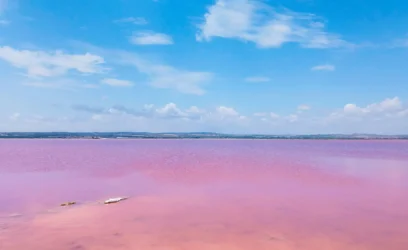
Tucked away on the Alicante coast lies a hidden treasure that seems straight out of a fairytale: The Pink Lagoon of Torrevieja (Laguna Rosa de Torrevieja). Its pink waters stand in stark contrast to the blue of the Mediterranean, and this salt lagoon is a rare natural phenomenon and one of the region’s most charming secrets. If you’re planning a holiday to the south of Spain, you simply must include this unique destination on your itinerary!
The lagoon’s surreal colour is due to the presence of microalgae and halophilic bacteria, which produce reddish pigments when exposed to the sun and high salinity. The more intense the heat, the more vibrant the pink hue becomes, creating a truly Instagram-worthy scene!
What’s more, the Pink Lagoon is part of the Parque Natural de Las Lagunas de La Mata y Torrevieja, a protected area home to flamingos and other migratory birds, which makes the location even more special.
In this post, you’ll discover how to visit, get useful tips for the region, and learn some fun facts about this surprising spot (including rumours about aliens).
Where is the Pink Lagoon and how do you get there?
The Pink Lagoon is located in Torrevieja, a coastal town in the province of Alicante, approximately 50 km south of Alicante and 60 km north of Cartagena. It is one of two large lagoons within the Parque Natural de Las Lagunas de La Mata y Torrevieja, and is the most famous due to its unique colouration.
The lagoon is just 4 km from the centre of Torrevieja, and you can get there in a few different ways:
By Car
This is your best option, as there is parking nearby. Simply head towards the Natural Park and park near the salt flats. The streets are narrow, but you can usually find a space just a short walk away.
By Bus
Local bus routes in Torrevieja stop near the lagoon, but they all require a short walk. The main routes are:
- Line C (Torrevieja-Lomas) – Stops: Cruz Roja and Residencia 3ª Edad
- Lines B and G (Torrevieja-Torretas / San Luis-La Siesta) Stops: C.C. Carrefour (Carrefour Shopping Centre) and C.C. Habaneras (Habaneras Shopping Centre)
By Bicycle or on Foot
If you’re staying in Torrevieja, you can hire a bike or enjoy a pleasant walk along the trail to the lagoon.
Useful tips for visiting the Pink Lagoon
Best time of year to visit: Aim for May to September, when the heat intensifies the pink colour of the water.
Best time of day: Visit in the morning or late afternoon, as the sunlight truly brings out the water’s pink tones. The sunset here is incredible, though unfortunately, the weather started to turn on the day we visited, so we missed it.
Suitable footwear: Wear comfortable trainers or proper walking sandals. The area around the lagoon is sandy and can be slippery in spots with crystallised salt.
Swimming is not allowed: This is a protected nature reserve, so swimming is strictly forbidden. While you might see some people ignoring the rule, please don’t be one of them. It’s far better to respect the local ecosystem and simply enjoy the view.
Bring water and sun cream: Tourist facilities on-site are limited or rather, non-existent. So, be sure to go prepared.
Drones require a permit: If you want to capture aerial shots, you must check the local regulations first.
Combine it with other trips: We weren’t particularly fond of Torrevieja itself, but the surrounding area is beautiful. It’s well worth exploring the region’s stunning beaches and coves, taking a side trip to see the Pink Lagoon while you’re passing through.
Watch for flamingos and birds: The lagoon is a wildlife sanctuary, perfect for nature lovers. On the way there, you’ll pass smaller lagoons and both active and disused salt flats, where you can see lots and lots of flamingos.








Fun Facts about the Pink Lagoon
Why is the water pink?
The colouration comes from a combination of a specific type of microalga (Dunaliella salina) and halophilic bacteria that thrive in saline environments.
When the salt concentration is high and sunlight is strong, the water takes on hues ranging from light pink to a deep fuchsia. This pink colour also appears in other places around the world, such as Lake Retba in Senegal and Lake Hillier in Australia.
Any signs of alien life?
Well… not officially.
But the lagoon’s surreal tones, combined with the crystallised salt flats, have given rise to wild theories and YouTube conspiracy videos suggesting everything from “interdimensional portals” to “submerged alien bases”.
It’s all good fun and makes for a great themed selfie with the hashtag #DayTripToMars.
One of Europe’s largest salt flats
The region is one of the continent’s main sources of salt, with production still active today.
The lagoon has been used for salt production since Roman times.
Is it Instagrammable? Absolutely!
The Pink Lagoon is a true spectacle. Whether you want to take artistic photos, capture family moments, or make creative videos, the landscape provides plenty of material. Just remember to respect the environmental rules.
Unfortunately, no matter how hard I tried, my photos couldn’t quite capture what I saw with my own eyes. And if your photos don’t fully capture the magic of the place, don’t worry – the best memories are the ones you keep in your head.
Conclusion
The combination of nature, science, legend, and beauty makes this a unique destination for curious travellers and lovers of the unusual. So, we highly recommend a visit to the Pink Lagoon. It’s one of those places that looks like science fiction but is very much real. If you’re looking for a different kind of destination, full of natural beauty and great photo opportunities, then this is an unmissable stop on your trip along the Costa Blanca.
Have you already been, or are you planning to add it to your itinerary? Let us know!


